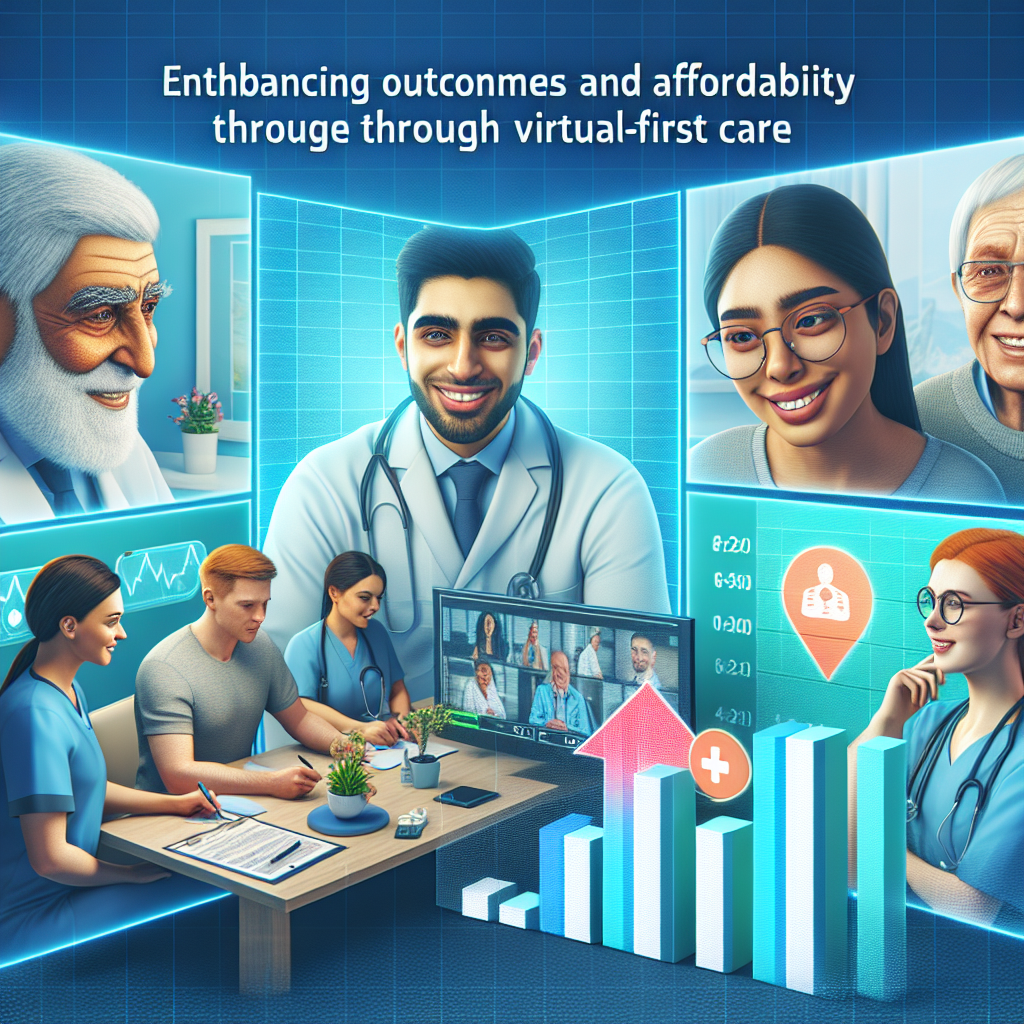Enhancing Outcomes and Affordability Through Virtual-First Care

In recent years, the healthcare industry has witnessed a significant transformation with the advent of virtual-first care. This innovative approach leverages technology to provide healthcare services remotely, offering a promising solution to enhance patient outcomes and affordability. As healthcare systems worldwide grapple with increasing costs and demand for services, virtual-first care emerges as a viable strategy to address these challenges. This article delves into the various facets of virtual-first care, exploring its potential to revolutionize healthcare delivery.
The Rise of Virtual-First Care
Virtual-first care is a model that prioritizes digital interactions as the initial point of contact between patients and healthcare providers. This approach has gained traction due to advancements in telemedicine, digital health tools, and the growing acceptance of remote care among patients and providers alike. The COVID-19 pandemic further accelerated the adoption of virtual-first care, highlighting its potential to deliver quality healthcare while minimizing physical contact.
Understanding Virtual-First Care
Virtual-first care is not merely about replacing in-person visits with video calls. It encompasses a comprehensive approach that integrates various digital tools and platforms to deliver holistic care. This model emphasizes proactive and preventive care, leveraging data analytics and artificial intelligence to identify health risks and intervene early. By prioritizing virtual interactions, healthcare providers can efficiently manage patient populations, reduce unnecessary hospital visits, and improve overall health outcomes.
One of the key components of virtual-first care is telemedicine, which enables patients to consult with healthcare professionals remotely. This not only enhances accessibility but also reduces the burden on healthcare facilities. Additionally, virtual-first care often incorporates remote monitoring devices, allowing continuous tracking of patients’ health metrics. This data-driven approach empowers providers to make informed decisions and tailor treatment plans to individual needs.
Benefits of Virtual-First Care
The benefits of virtual-first care extend beyond convenience. By reducing the need for physical visits, this model can significantly lower healthcare costs for both patients and providers. Patients save on travel expenses and time, while providers can optimize their resources and reach a larger patient base. Moreover, virtual-first care enhances access to healthcare services, particularly for individuals in remote or underserved areas.
Another advantage of virtual-first care is its potential to improve patient engagement and adherence to treatment plans. Digital platforms facilitate continuous communication between patients and providers, enabling timely interventions and personalized care. This proactive approach fosters a sense of empowerment among patients, encouraging them to take an active role in managing their health.
Challenges and Considerations
While virtual-first care offers numerous benefits, it also presents certain challenges that need to be addressed. One of the primary concerns is ensuring the security and privacy of patient data. As healthcare providers increasingly rely on digital platforms, robust cybersecurity measures are essential to protect sensitive information. Additionally, there is a need for standardized protocols and guidelines to ensure the quality and safety of virtual care services.
Another challenge is the digital divide, which can limit access to virtual-first care for certain populations. Not all individuals have access to the necessary technology or internet connectivity, potentially exacerbating health disparities. To address this issue, policymakers and healthcare organizations must work towards bridging the digital gap and ensuring equitable access to virtual care services.
Case Studies: Successful Implementation of Virtual-First Care
Several healthcare organizations have successfully implemented virtual-first care models, demonstrating their potential to enhance outcomes and affordability. For instance, Kaiser Permanente, a leading integrated healthcare system in the United States, has embraced virtual-first care as a core component of its service delivery. By leveraging telemedicine and remote monitoring, Kaiser Permanente has improved patient satisfaction, reduced hospital admissions, and achieved cost savings.
Another notable example is the United Kingdom’s National Health Service (NHS), which has integrated virtual-first care into its long-term plan. The NHS has launched various digital initiatives, such as the NHS App and online consultations, to enhance access to healthcare services. These efforts have not only improved patient experience but also alleviated pressure on healthcare facilities, particularly during the COVID-19 pandemic.
Technological Innovations Driving Virtual-First Care
The success of virtual-first care hinges on the effective use of technology. Recent advancements in digital health tools and platforms have paved the way for more efficient and personalized care delivery. From telemedicine to artificial intelligence, these innovations are transforming the healthcare landscape and enabling the widespread adoption of virtual-first care.
Telemedicine: The Backbone of Virtual-First Care
Telemedicine is a cornerstone of virtual-first care, facilitating remote consultations between patients and healthcare providers. This technology has evolved significantly over the years, offering a range of services from video consultations to remote diagnostics. Telemedicine platforms enable real-time communication, allowing providers to assess patients’ conditions, prescribe medications, and offer medical advice without the need for in-person visits.
The convenience and accessibility of telemedicine have made it a popular choice among patients and providers alike. According to a report by McKinsey & Company, telehealth usage in the United States increased by 38 times from pre-COVID-19 levels in 2020. This surge in adoption highlights the growing acceptance of telemedicine as a viable alternative to traditional healthcare delivery.
Remote Monitoring Devices: Enhancing Patient Care
Remote monitoring devices play a crucial role in virtual-first care by enabling continuous tracking of patients’ health metrics. These devices, such as wearable sensors and smart home health equipment, collect real-time data on vital signs, activity levels, and other health indicators. This information is transmitted to healthcare providers, allowing them to monitor patients’ conditions and intervene promptly if necessary.
Remote monitoring devices are particularly beneficial for managing chronic conditions, such as diabetes and hypertension. By providing real-time insights into patients’ health, these devices empower providers to make data-driven decisions and adjust treatment plans as needed. This proactive approach not only improves patient outcomes but also reduces the need for hospitalizations and emergency room visits.
Artificial Intelligence: Transforming Healthcare Delivery
Artificial intelligence (AI) is revolutionizing virtual-first care by enhancing diagnostic accuracy, predicting health risks, and personalizing treatment plans. AI algorithms can analyze vast amounts of data from electronic health records, remote monitoring devices, and other sources to identify patterns and trends. This enables healthcare providers to detect early signs of disease, assess patient risk factors, and recommend preventive measures.
AI-powered chatbots and virtual assistants are also becoming integral components of virtual-first care. These tools can handle routine inquiries, schedule appointments, and provide health information, freeing up healthcare professionals to focus on more complex tasks. By automating administrative processes, AI enhances the efficiency of virtual care delivery and improves patient satisfaction.
Data Analytics: Driving Informed Decision-Making
Data analytics is a critical enabler of virtual-first care, providing valuable insights into patient populations and healthcare trends. By analyzing data from various sources, healthcare providers can identify high-risk patients, track disease progression, and evaluate the effectiveness of treatment interventions. This data-driven approach supports evidence-based decision-making and enhances the quality of care.
Predictive analytics, a subset of data analytics, is particularly valuable in virtual-first care. By leveraging machine learning algorithms, predictive analytics can forecast patient outcomes and identify potential health risks. This enables providers to implement targeted interventions and allocate resources more effectively, ultimately improving patient outcomes and reducing healthcare costs.
Interoperability: Ensuring Seamless Integration
Interoperability is a key consideration in the implementation of virtual-first care, as it ensures seamless integration between different digital health tools and platforms. Interoperability enables the exchange of data across various systems, allowing healthcare providers to access comprehensive patient information and deliver coordinated care.
Achieving interoperability requires standardized data formats and protocols, as well as collaboration between technology vendors, healthcare organizations, and regulatory bodies. By fostering interoperability, the healthcare industry can unlock the full potential of virtual-first care and create a more connected and efficient healthcare ecosystem.
Improving Patient Engagement and Experience
Patient engagement is a critical factor in the success of virtual-first care. By fostering active participation in healthcare decisions and promoting self-management, virtual-first care can enhance patient experience and improve health outcomes. Digital tools and platforms play a pivotal role in facilitating patient engagement, offering personalized and interactive experiences that empower individuals to take charge of their health.
Personalized Care Plans: Tailoring Treatment to Individual Needs
Virtual-first care enables the creation of personalized care plans that cater to the unique needs and preferences of each patient. By leveraging data from electronic health records, remote monitoring devices, and patient-reported outcomes, healthcare providers can develop customized treatment plans that align with patients’ goals and lifestyles.
Personalized care plans enhance patient engagement by involving individuals in the decision-making process and encouraging them to take an active role in managing their health. This collaborative approach fosters a sense of ownership and accountability, motivating patients to adhere to treatment recommendations and make positive lifestyle changes.
Interactive Digital Platforms: Enhancing Communication and Education
Interactive digital platforms are integral to virtual-first care, providing patients with access to a wealth of information and resources. These platforms offer educational content, self-assessment tools, and interactive features that empower patients to learn about their conditions and make informed decisions about their care.
Digital platforms also facilitate communication between patients and healthcare providers, enabling timely feedback and support. Through secure messaging, video consultations, and virtual support groups, patients can connect with their care teams and receive guidance when needed. This continuous communication fosters trust and strengthens the patient-provider relationship, ultimately enhancing patient experience.
Gamification: Motivating Healthy Behaviors
Gamification is an innovative strategy used in virtual-first care to motivate healthy behaviors and improve patient engagement. By incorporating game-like elements, such as rewards, challenges, and leaderboards, digital health platforms can make health management more engaging and enjoyable for patients.
Gamification encourages patients to set and achieve health goals, track their progress, and celebrate their successes. This approach not only enhances motivation but also promotes adherence to treatment plans and lifestyle modifications. By making health management fun and rewarding, gamification can drive positive behavior change and improve health outcomes.
Patient Portals: Empowering Self-Management
Patient portals are a valuable tool in virtual-first care, providing individuals with access to their health information and enabling self-management. Through patient portals, individuals can view their medical records, track their health metrics, schedule appointments, and communicate with their care teams.
By empowering patients with access to their health data, patient portals promote transparency and accountability. Patients can actively participate in their care, monitor their progress, and make informed decisions about their health. This sense of empowerment enhances patient engagement and fosters a collaborative approach to healthcare delivery.
Feedback Mechanisms: Continuously Improving Care
Feedback mechanisms are essential in virtual-first care, enabling healthcare providers to gather insights from patients and continuously improve the quality of care. Through surveys, questionnaires, and real-time feedback tools, providers can assess patient satisfaction, identify areas for improvement, and tailor services to meet patients’ needs.
By actively seeking and incorporating patient feedback, healthcare organizations can enhance the patient experience and build trust with their patient populations. This commitment to continuous improvement fosters a culture of patient-centered care and ensures that virtual-first care services remain responsive and relevant.
Addressing Health Disparities Through Virtual-First Care
Health disparities are a significant challenge in healthcare, with certain populations experiencing unequal access to services and poorer health outcomes. Virtual-first care has the potential to address these disparities by improving access to healthcare services and promoting equity in care delivery. By leveraging technology, virtual-first care can reach underserved populations and provide timely interventions that improve health outcomes.
Expanding Access to Underserved Areas
One of the primary benefits of virtual-first care is its ability to expand access to healthcare services in underserved areas. Rural and remote communities often face barriers to accessing healthcare, such as long travel distances and limited availability of providers. Virtual-first care overcomes these barriers by enabling remote consultations and reducing the need for in-person visits.
By leveraging telemedicine and digital health tools, healthcare providers can reach patients in underserved areas and deliver timely care. This not only improves access to services but also reduces the burden on healthcare facilities in urban centers. By expanding access to care, virtual-first care can help reduce health disparities and improve health outcomes for underserved populations.
Addressing Socioeconomic Barriers
Socioeconomic factors, such as income and education, can significantly impact access to healthcare services. Virtual-first care has the potential to address these barriers by offering affordable and convenient healthcare options. By reducing the need for travel and minimizing out-of-pocket expenses, virtual-first care can make healthcare more accessible to individuals with limited financial resources.
Additionally, virtual-first care can provide educational resources and support to individuals with lower health literacy. Digital platforms offer interactive and user-friendly content that empowers individuals to learn about their health conditions and make informed decisions. By addressing socioeconomic barriers, virtual-first care can promote equity in healthcare delivery and improve health outcomes for disadvantaged populations.
Cultural Competence in Virtual Care
Cultural competence is a critical consideration in virtual-first care, as it ensures that healthcare services are respectful and responsive to the diverse needs of patients. Virtual-first care offers opportunities to enhance cultural competence by providing personalized and culturally sensitive care.
Digital platforms can offer language translation services, culturally relevant educational materials, and access to providers who understand patients’ cultural backgrounds. By fostering cultural competence, virtual-first care can improve patient satisfaction and engagement, ultimately enhancing health outcomes for diverse populations.
Reducing Health Disparities Through Data-Driven Interventions
Data analytics plays a crucial role in addressing health disparities through virtual-first care. By analyzing data on social determinants of health, healthcare providers can identify at-risk populations and implement targeted interventions. This data-driven approach enables providers to allocate resources effectively and deliver personalized care that addresses the unique needs of each patient.
Predictive analytics can also help identify potential health risks and prevent adverse outcomes. By leveraging machine learning algorithms, healthcare providers can forecast patient outcomes and implement preventive measures. This proactive approach not only improves health outcomes but also reduces health disparities by ensuring that all patients receive timely and appropriate care.
Collaborative Efforts to Promote Health Equity
Addressing health disparities through virtual-first care requires collaboration between healthcare organizations, policymakers, and community stakeholders. By working together, these entities can develop strategies to promote health equity and ensure that virtual-first care services are accessible to all individuals.
Collaborative efforts may include initiatives to bridge the digital divide, such as providing access to technology and internet connectivity in underserved areas. Additionally, partnerships with community organizations can help raise awareness of virtual-first care services and promote their adoption among diverse populations. By fostering collaboration, the healthcare industry can create a more equitable and inclusive healthcare system.
The Future of Virtual-First Care
The future of virtual-first care is promising, with continued advancements in technology and growing acceptance among patients and providers. As healthcare systems worldwide seek to enhance outcomes and affordability, virtual-first care is poised to play a pivotal role in transforming healthcare delivery. By embracing innovation and addressing challenges, the healthcare industry can unlock the full potential of virtual-first care and create a more efficient and equitable healthcare system.
Integration with Traditional Healthcare Models
As virtual-first care continues to evolve, it is essential to integrate it with traditional healthcare models to create a seamless and comprehensive care experience. Hybrid models that combine virtual and in-person care can offer the best of both worlds, providing patients with flexibility and choice in how they receive care.
Integration efforts may include developing standardized protocols for transitioning between virtual and in-person care, as well as ensuring interoperability between digital platforms and electronic health records. By creating a cohesive healthcare ecosystem, providers can deliver coordinated and patient-centered care that meets the diverse needs of individuals.
Advancements in Technology and Innovation
The future of virtual-first care will be shaped by continued advancements in technology and innovation. Emerging technologies, such as virtual reality, augmented reality, and blockchain, have the potential to enhance virtual care delivery and improve patient outcomes.
Virtual reality and augmented reality can offer immersive and interactive experiences for patients, enhancing education and engagement. Blockchain technology can improve data security and interoperability, ensuring the safe and seamless exchange of health information. By embracing these innovations, the healthcare industry can further enhance the quality and efficiency of virtual-first care.
Policy and Regulatory Considerations
The widespread adoption of virtual-first care requires supportive policies and regulations that promote innovation while ensuring patient safety and privacy. Policymakers must work towards creating a regulatory framework that facilitates the integration of virtual-first care into healthcare systems.
Key considerations may include reimbursement policies for virtual care services, data privacy regulations, and guidelines for telemedicine practice. By establishing a supportive policy environment, governments can encourage the adoption of virtual-first care and drive positive change in healthcare delivery.
Empowering Patients Through Education and Awareness
Empowering patients through education and awareness is essential for the success of virtual-first care. Healthcare organizations must invest in initiatives that raise awareness of virtual care options and educate patients on how to access and use digital health tools.
Efforts may include community outreach programs, educational campaigns, and partnerships with patient advocacy groups. By empowering patients with knowledge and resources, healthcare providers can promote the adoption of virtual-first care and enhance patient engagement and satisfaction.
Building a Sustainable and Equitable Healthcare System
The ultimate goal of virtual-first care is to build a sustainable and equitable healthcare system that delivers high-quality care to all individuals. By leveraging technology and innovation, virtual-first care can enhance outcomes, reduce costs, and promote health equity.
Achieving this goal requires collaboration between healthcare providers, policymakers, technology vendors, and community stakeholders. By working together, these entities can create a healthcare system that is responsive to the needs of patients and adaptable to the challenges of the future.
Conclusion
Virtual-first care represents a transformative approach to healthcare delivery, offering a promising solution to enhance outcomes and affordability. By leveraging technology and innovation, virtual-first care can improve access to services, promote patient engagement, and address health disparities. As the healthcare industry continues to evolve, virtual-first care is poised to play a pivotal role in shaping the future of healthcare delivery.
To unlock the full potential of virtual-first care, stakeholders must address challenges related to data security, interoperability, and equitable access. By fostering collaboration and embracing innovation, the healthcare industry can create a more efficient, equitable, and patient-centered healthcare system that meets the diverse needs of individuals worldwide.





